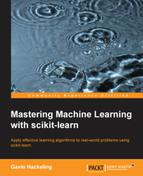In this chapter we discussed three cases of linear regression. We worked through an example of simple linear regression, which models the relationship between a single explanatory variable and a response variable using a line. We then discussed multiple linear regression, which generalizes simple linear regression to model the relationship between multiple explanatory variables and a response variable. Finally, we described polynomial regression, a special case of multiple linear regression that models non-linear relationships between explanatory variables and a response variable. These three models can be viewed as special cases of the generalized linear model, a framework for model linear relationships, which we will discuss in more detail in Chapter 4, From Linear Regression to Logistic Regression.
We assessed the fitness of models using the residual sum of squares cost function and discussed two methods to learn the values of a model's parameters that minimize the cost function. First, we solved the values of the model's parameters analytically. We then discussed gradient descent, a method that can efficiently estimate the optimal values of the model's parameters even when the model has a large number of features. The features in this chapter's examples were simple measurements of their explanatory variables; it was easy to use them in our models. In the next chapter, you will learn to create features for different types of explanatory variables, including categorical variables, text, and images.
